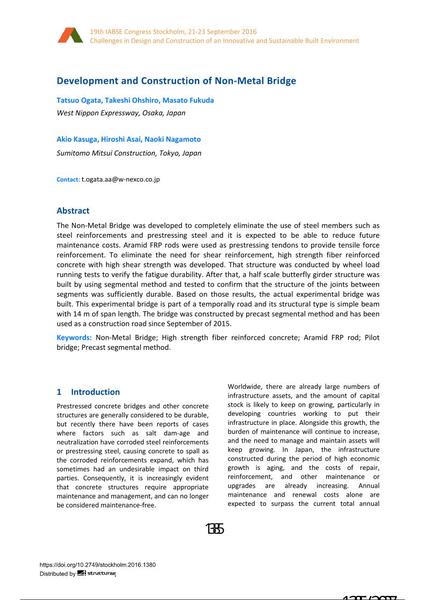Development and Construction of Non-Metal Bridge

|
|
|||||||||||
Détails bibliographiques
| Auteur(s): |
Tatsuo Ogata
(West Nippon Expressway, Osaka, Japan)
Takeshi Ohshiro (West Nippon Expressway, Osaka, Japan) Masato Fukuda (West Nippon Expressway, Osaka, Japan) Akio Kasuga (Sumitomo Mitsui Construction, Tokyo, Japan) Hiroshi Asai (Sumitomo Mitsui Construction, Tokyo, Japan) Naoki Nagamoto (Sumitomo Mitsui Construction, Tokyo, Japan) |
||||
|---|---|---|---|---|---|
| Médium: | papier de conférence | ||||
| Langue(s): | anglais | ||||
| Conférence: | IABSE Congress: Challenges in Design and Construction of an Innovative and Sustainable Built Environment, Stockholm, Sweden, 21-23 September 2016 | ||||
| Publié dans: | IABSE Congress Stockholm, 2016 | ||||
|
|||||
| Page(s): | 1385-1393 | ||||
| Nombre total de pages (du PDF): | 9 | ||||
| Année: | 2016 | ||||
| DOI: | 10.2749/stockholm.2016.1380 | ||||
| Abstrait: |
The Non-Metal Bridge was developed to completely eliminate the use of steel members such as steel reinforcements and prestressing steel and it is expected to be able to reduce future maintenance costs. Aramid FRP rods were used as prestressing tendons to provide tensile force reinforcement. To eliminate the need for shear reinforcement, high strength fiber reinforced concrete with high shear strength was developed. That structure was conducted by wheel load running tests to verify the fatigue durability. After that, a half scale butterfly girder structure was built by using segmental method and tested to confirm that the structure of the joints between segments was sufficiently durable. Based on those results, the actual experimental bridge was built. This experimental bridge is part of a temporally road and its structural type is simple beam with 14 m of span length. The bridge was constructed by precast segmental method and has been used as a construction road since September of 2015. |
||||
